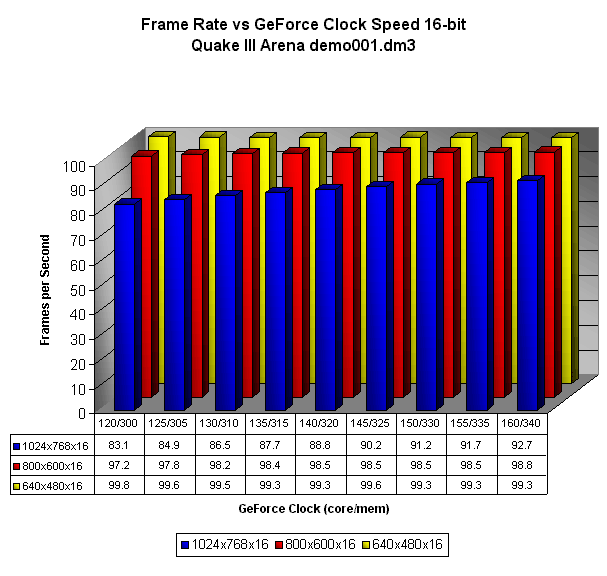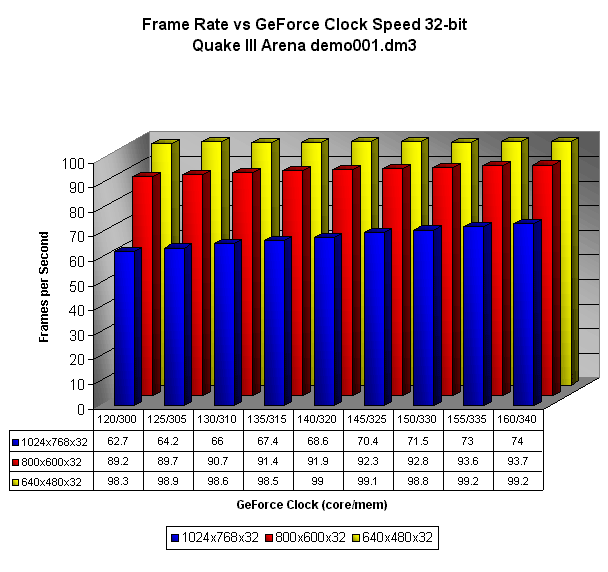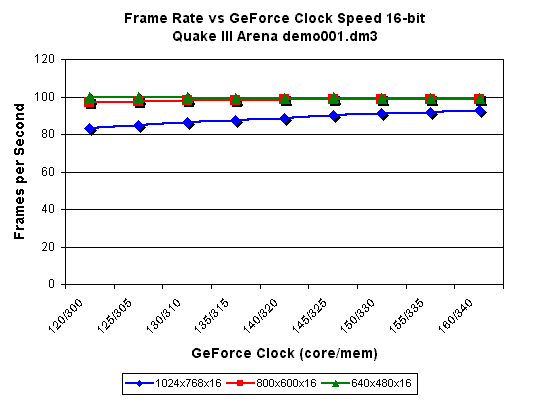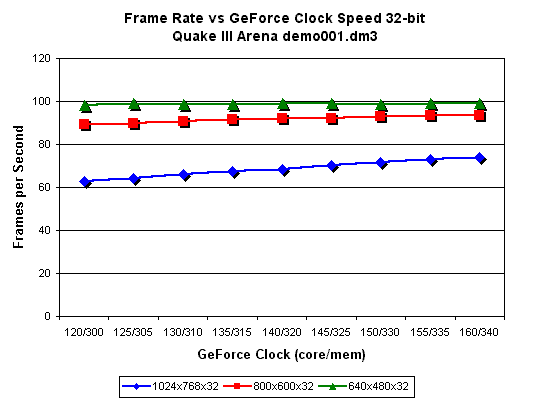NVIDIA GeForce DDR Roundup (March 00)
by Matthew Witheiler on March 7, 2000 4:13 AM EST- Posted in
- GPUs
Overclocking Outcome
If your DDR GeForce card can handle the high stresses of overclocking, it would be nice to see how much performance is gained by pushing the core and memory clock speeds of DDR GeForce cards. To measure how much increase can be expected by overclocking we took one of our most overclockable cards, the Leadtek WinFast GeForce 256 DDR Rev B, and overclocked the core and memory speeds in increments of 5 MHz using PowerStrip. The resulting frame rate was then recorded during a run of Quake III Arena's demo001.dm3 demo on a Pentium III 550E. Below is a graph of the results in both 16-bit and 32-bit colors.


The results of overclocking the DDR GeForce were a bit different than the results that were obtained in our SDR Roundup. In the case of the DDR cards, a linear increase in FPS rating is apparent only at higher resolutions and colors, mainly 1024x768x16 and 1024x768x32 and is also seen at 800x600x32 to some extent. It seems that in all other cases, the FPS rate has hit some sort of limiting value that can not be surpassed no matter what the clock speed is. For the SDR GeForce, this limiting value was only really seen at 640x480x16, but in the case of the DDR GeForce, limiting values are seen not only at this resolution but also at 640x480x32 and 800x600x16 where the FPS rating seems to max out at 99.2 and 98.5 FPS respectively.
These results show that the GeForce is capable of keeping up with the CPU and the Quake III engine at these colors and resolutions due to the fact that the video card is not causing any bottleneck in the system as displayed by the fact that overclocking the memory and core speed do not result in an increase in FPS rating. We can also see that the memory clock speed is the one factor that really limits SDR cards because DDR cards running at the same core speed result in a limiting speed where SDR cards were not limited. The two graphs below show the linear relationship between clock speed and FPS rating, as well as showing the limiting values reached.


While at 640x480x16, 640x480x32, and 800x600x16, the FPS rating reaches limiting values, at 800x600x32, 1024x768x16, and 1024x768x32 all seem to show an increasing linear relationship between the values. With this information , an equation can be written that estimates the performance gain that occurs with an increase in clock speed. For example, at 800x600x32, the linear function which bests fits the trend in the data is y = 0.116x + 89.38. This means that for every 1 MHz you overclock both the core and memory speed over the stock speeds of 120/300 MHz, you can expect the FPS rate to increase 0.116 FPS. Equations for the other resolutions that can be modeled linearly are shown in the table below, but keep in mind that individual results may vary and these numbers are for reference purposes only.
|
Resolution |
Equation |
|
640 x 480 x 16 |
N/A |
|
640 x 480 x 32 |
N/A |
|
800 x 600 x 16 |
N/A |
|
800 x 600 x 32 |
y = 0.116x + 89.38 |
|
1024 x 768 x 16 |
y = 0.2358x + 83.819 |
|
1024 x 768 x 32 |
y = 0.2853x + 62.94 |
As can be seen by the above functions, overclocking the DDR GeForce to a speed of 160 MHz in the core and 340 MHz in the memory clock is where the difference is most pronounced. If your DDR GeForce can reach these high speeds without image quality loss or system failure, expect the overclocked card to perform 18 % better in Quake III Arena at 1024x768x32. In addition, the equation shows that you can expect a 0.2853 FPS increase in performance per MHz when overclocked at this resolution. At 1024x768x16 the card performed 12% faster when overclocked to its full potential and the resulting FPS increase per MHz at this speed was 0.2358. Finally, the difference between the overclocked card and the stock card was least noticeable (compared to other resolutions where the FPS rate increases in a linear fashion) in the resolution of 800x600x32 when the performance gain was 5% and 0.116 FPS per MHz.
Now that we know a bit about the GeForce processor, how its memory works and how it responds to overclocking, we can now take a look at a handful of DDR GeForce cards and examine how each card rates in overclockability, driver set, and examine the general pros and cons of each card.










0 Comments
View All Comments